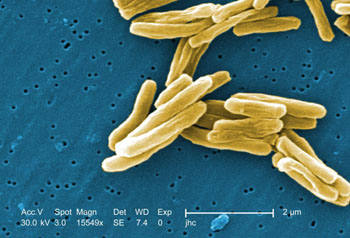PCR-Based Blood Test Accurately Diagnoses Active Tuberculosis
By LabMedica International staff writers
Posted on 06 Mar 2016
A panel of three genes has been established that accurately distinguishes individuals with active tuberculosis (TB) from healthy individuals or from patients with chronic TB or AIDS.Posted on 06 Mar 2016
Active pulmonary tuberculosis is difficult to diagnose and treatment response is difficult to monitor effectively. In response to a World Health Organization (WHO) call for new non-sputum diagnostics, investigators at Stanford University (Palo Alto, CA, USA) developed a simple, PCR-based assay to test for active TB in samples of patients' blood.

Image: High magnification (15,549 x) scanning electron micrograph (SEM) showing a number of Gram-positive Mycobacterium tuberculosis bacteria (Photo courtesy of the CDC – US Centers for Disease Control and Prevention).
The investigators screened a total of 14 datasets containing 2,572 samples from 10 countries from both adult and pediatric patients. Of these, three datasets comprising 1,023 samples were used to discover a set of three genes (GBP5, DUSP3, and KLF2) that were highly diagnostic for active tuberculosis.
The diagnostic power of the three gene set to separate active tuberculosis from healthy controls, latent tuberculosis, and other diseases was validated in eight independent datasets composed of both children and adults from ten countries. The assay was shown to be 86% sensitive and 99% in children.
Expression of the three-gene set was not masked by HIV infection status, bacterial drug resistance, or BCG vaccination. Furthermore, in four additional cohorts, the investigators showed that the tuberculosis score declined during treatment of patients with active tuberculosis.
"One-third of the world's population is currently infected with TB. Even if only 10% of them get active TB, that is still 3% of the world's population—240 million people," said senior author Dr. Purvesh Khatri, assistant professor of medicine at Stanford University.
The study was published in the February 19, 2016, online edition of the journal Lancet Respiratory Medicine.
Related Links:
Stanford University














